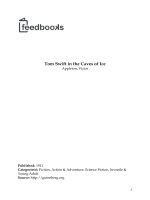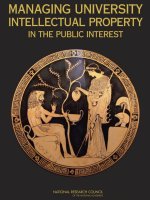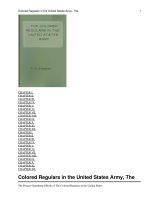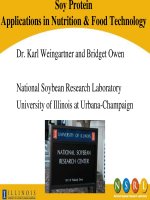Intellectual Property in the Food Technology Industry potx
Bạn đang xem bản rút gọn của tài liệu. Xem và tải ngay bản đầy đủ của tài liệu tại đây (1.16 MB, 152 trang )
Intellectual Property in the Food
Technology Industry
Ryan W. O’Donnell · John J. O’Malley ·
Randolph J. Huis · Gerald B. Halt, Jr.
Intellectual Property
in the Food Technology
Industry
Protecting Your Innovation
123
Ryan W. O’Donnell
Volpe and Koenig, P.C.,
Philadelphia, PA,USA
John J. O’Malley
Volpe and Koenig, P.C.,
Philadelphia, PA,USA
Randolph J. Huis
Volpe and Koenig, P.C.,
Philadelphia, PA,USA
Gerald B. Halt, Jr.
Volpe and Koenig, P.C.,
Philadelphia, PA,USA
Printed on acid-free paper
springer.com
The authors are all shareholders at the intellectual property law firm of Volpe and Koenig, P.C., and
have extensive industry and legal experience. Volpe and Koenig provides guidance on matters relating
to patents, trademarks, copyrights, trade secrets, e-commerce, technology joint ventures, non-disclosure
agreements, technology acquisitions, licensing and litigation. In addition to food technology, the firm
has experience in the electronics, consumer goods, wireless technology, mechanical, medical, chemical,
biotechnical and pharmaceutical industries. For more information about the authors or Volpe and Koenig,
P.C. please visit www.volpe-koenig.com.
ISBN: 978-0-387-77388-9 e-ISBN: 978-0-387-77389-6
DOI: 10.1007/978-0-387-77389-6
Library of Congress Control Number: 2008926489
c
2008 Springer Science+Business Media, LLC
All rights reserved. This work may not be translated or copied in whole or in part without the written
permission of the publisher (Springer Science+Business Media, LLC, 233 Spring Street, New York,
NY 10013, USA), except for brief excerpts in connection with reviews or scholarly analysis. Use in
connection with any form of information storage and retrieval, electronic adaptation, computer
software, or by similar or dissimilar methodology now known or hereafter developed is forbidden.
The use in this publication of trade names, trademarks, service marks, and similar terms, even if
they are not identified as such, is not to be taken as an expression of opinion as to whether or not
they are subject to proprietary rights.
Acknowledgments
The authors would like to thank everyone at the law firm of Volpe and
Koenig, P.C. for providing support and encouragement in preparing this
book. The authors would also like to individually thank Anthony S. Volpe
for his contribution to the intellectual property enforcement and litigation
chapter, C. Frederick Koenig III for his contribution to the copyright chapter,
and Stephen B. Schott for his contribution to the overall organization and
editing of this book.
v
Contents
Part I Overview of Intellectual Property Rights
1Patents 3
1.1 What Is a Patent and Why Apply for a Patent? . . . . . . . . . . . 3
1.2 TypesofPatentsandApplications 4
1.3 ProvisionalPatentApplications 7
1.4 ThePatentApplicationParts 7
1.4.1 Claims 8
1.4.2 Specification 9
1.4.3 Inventorship 10
1.4.4 When Should You Apply for a Patent Application? 11
1.4.5 PatentExamination 13
1.4.6 ContinuingApplications 13
1.5 Patentability Requirements . . . . . . . . . . . . . . . . . . . . . . . . . . . 15
1.5.1 PatentableSubjectMatter 15
1.5.2 Utility Requirement . . . . . . . . . . . . . . . . . . . . . . . . . . 16
1.5.3 NoveltyRequirement 17
1.6 InternationalPatentRights 21
2 Trade Secret Protection 23
2.1 WhatIsaTradeSecret? 23
2.2 MisappropriationofTradeSecrets 26
2.3 ReverseEngineeringofTradeSecrets 28
3 Trademarks and Trade Dress 29
3.1 WhatIsaTrademark? 29
3.2 BrandSelectionandDevelopment 31
3.3 Non-protectable Subject Matter . . . . . . . . . . . . . . . . . . . . . . . 33
3.4 SelectingaTrademark 34
3.4.1 BrainstormingPhase 34
vii
viii Contents
3.4.2 NarrowingPhase 34
3.4.3 Knockout Phase . . . . . . . . . . . . . . . . . . . . . . . . . . . . . 34
3.4.4 ClearanceSearch 35
3.4.5 ObtaininganOpinion 35
3.5 ProtectingtheMark 36
3.5.1 CommonLawofTrademark 36
3.5.2 Federal Trademark Protection . . . . . . . . . . . . . . . . . 37
3.5.3 StateRegistrations 40
3.5.4 MaintainingRights 40
3.5.5 InternationalProtection 43
4 Copyrights 47
4.1 Copyrightable Subject Matter and Scope of Protection . . . . 47
4.1.1 Foods as Copyrightable Subject Matter . . . . . . . . . . 47
4.1.2 Advertising, Marketing Materials, and Packaging . 48
4.1.3 Secret and Other Materials Including Recipes
andSoftware 49
4.2 Ownership/Authorship . . . . . . . . . . . . . . . . . . . . . . . . . . . . . . 50
4.2.1 WorksforHire 51
4.2.2 JointlyAuthoredWorks 51
4.2.3 Copyright Transfers: Assignment and Licensing . . 52
4.3 DerivativeWorks 53
4.4 FairUse 53
4.5 RegistrationIssues 55
5 Domain Names 59
5.1 Securing Intellectual Property in Domain Names . . . . . . . . 59
5.2 DomainNameDisputes 61
6 Intellectual Property Issues in Labeling
and Marketing 65
6.1 Governmental Controls Over Advertisements
andLabeling 65
6.1.1 Federal Trade Commission (“FTC”) . . . . . . . . . . . . 65
6.1.2 FoodandDrugAdministration(“FDA”) 67
6.1.3 US Department of Agriculture (“USDA”). . . . . . . . 69
6.1.4 Alcohol and Tobacco Tax and Trade Bureau (TTB) 69
6.1.5 StateRegulation 70
6.1.6 Governmental Controls Outside of the United
States 70
6.2 Non-Governmental Controls. . . . . . . . . . . . . . . . . . . . . . . . . . 71
6.3 ComparativeAdvertising 72
Contents ix
Part II Implementing IP Practices and Procedures
7 Seven Basic Steps to Getting Started 77
7.1 Confidential Disclosure or Non-Disclosure Agreements . . . 77
7.2 AssignmentofRights 80
7.3 EmployeeEducation 81
7.4 AccurateRecordKeeping 82
7.4.1 Patents 82
7.4.2 TradeSecrets 83
7.5 PatentandTrademarkSearches 84
7.5.1 Patents 84
7.5.2 Trademarks 85
7.6 Decide on the Type of Protection Early
intheInventiveProcess 85
7.7 SpeaktoanIntellectualPropertyAttorney 85
8 Deciding Between Patent or Trade
Secret Protection 87
9 Developing and Managing an Intellectual Property Portfolio 91
9.1 Developing an Intellectual Property Portfolio Strategy . . . . 91
9.1.1 IdentificationofIPAssets 91
9.1.2 Determining Whether the Identified IP Assets
AreCoreAssets 92
9.1.3 Properly Allocating Corporate Resources to Core
and Non-Core IP Assets . . . . . . . . . . . . . . . . . . . . . . 92
9.1.4 Setting up a Program for Periodic Review of IP
Assets 93
9.2 Administrative Issues for Long-Term IP
PortfolioManagement 94
9.2.1 DocketManagement 94
9.3 Ongoing IP Diligence: Protecting Rights
andPursuingOthers 95
9.3.1 DefendingYourIP 95
9.3.2 LeveragingIPRights 97
10 Enforcement and Infringement of Intellectual Property Rights 99
10.1 PolicingYourIPRights 99
10.2 Evaluating a Controversy Prior
to Commencing Litigation . . . . . . . . . . . . . . . . . . . . . . . . . . . 101
10.3 RemediesandHowtoAchieveThem 102
10.3.1 Injunctions 102
x Contents
10.3.2 Payment of Royalties . . . . . . . . . . . . . . . . . . . . . . . . . 102
10.3.3 MonetaryDamages 103
10.4 Settling Controversy Without Litigation . . . . . . . . . . . . . . . . 103
10.4.1 Arbitration 103
10.4.2 Mediation 104
10.5 Litigation . . . . . . . . . . . . . . . . . . . . . . . . . . . . . . . . . . . . . . . . . 105
10.5.1 SelectingaJurisdiction 105
10.5.2 CausesofAction 105
10.5.3 Preliminary Injunctions . . . . . . . . . . . . . . . . . . . . . . . 107
10.5.4 Discovery 107
10.5.5 Summary Judgment . . . . . . . . . . . . . . . . . . . . . . . . . . 108
10.5.6 Trial 108
10.5.7 Costs 109
10.6 Proceedings in the US Patent and Trademark Office . . . . . . 109
10.6.1 Trademark Oppositions . . . . . . . . . . . . . . . . . . . . . . . 109
10.6.2 PatentInterference 110
10.6.3 PatentReexamination 110
11 Licensing Intellectual Property Rights 113
11.1 What Is an Intellectual Property License? . . . . . . . . . . . . . . . 113
11.2 FactorstoConsiderinanIPLicense 114
11.2.1 Identification of Rights to be Licensed . . . . . . . . . . 115
11.2.2 Restrictions 115
11.2.3 Consideration 116
11.2.4 MaintenanceofIPRights 117
11.2.5 OtherTerms 118
Appendix A 121
Appendix B 125
Appendix C 127
Appendix D 129
Appendix E 131
Index 139
Introduction
Creativity can create economic value. This maxim holds true equally for
the food industry as for other industries. Such value may come from a new
innovation, edging out competitors in a market, creating a revenue stream
where there was none, or increasing market reputation. This book provides
an introduction to intellectual property law, as applied to the food technology
industry. This area of law provides the legal framework for bridging creativ-
ity and the value that may come from it. Through the proper use of intellec-
tual property law, one has a much better chance of transforming creativity
into economic value.
Intellectual property law recognizes a creator’s rights in ideas, innova-
tions, and goodwill. Being intangible, intellectual property differs from real
property (land) or personal property (your possessions) that are secured, con-
trolled, and protected using physical means such as fences, locks, alarms, and
guards. Because intellectual property is a product of the mind, there is often
no easy way to build a “fence” around it. Consider one of the most valuable
trademarks in the world: Coca-Cola
. The Coca-Cola Company could not
protect this mark with a physical fence. It is intellectual property law that
provides a legal fence of trademark protection to protect the goodwill of the
Coca-Cola
trademark.
There are a variety of intellectual property pitfalls that await the unwary.
Different rules apply to different types of intellectual property (IP). Accord-
ingly, you may forfeit your rights if you do not take the appropriate measures
to secure and protect them. Thus, it is important to understand the types of
IP protection and the respective rules that govern each type of IP.
1. Patent: Patents may be granted for the invention of any new and use-
ful process, machine, manufacture or composition of matter, or any new
useful improvement thereof. A patent is a property right that grants the
inventor or owner the right to exclude others from making, using, selling,
or offering to sell the invention as defined by the patent’s claims in the
United States for a limited period of time.
xi
xii Introduction
2. Trademark: A trademark is a word, phrase, symbol, or design, or com-
bination of words, phrases, symbols, or designs which identifies and dis-
tinguishes the source of the goods or services of one party from those
of others. Trademarks promote competition by giving products corporate
identity and marketing leverage.
3. Copyright: Copyrights protect original works of authorship fixed in a
tangible medium of expression. Copyrighted works include literary, dra-
matic, and musical compositions, movies, pictures, paintings, sculptures,
computer programs, etc. Copyright protects the expression of an idea, but
not the idea itself.
4. Trade Secret: Generally, a trade secret is any formula, manufacturing pro-
cess, method of business, technical know-how, etc. that gives its holder a
competitive advantage and is not generally known. The legal definition of
a trade secret and the protection afforded to a trade secret owner varies
from state to state.
The table below highlights some of the attributes of and distinctions
between these different types of IP:
Introduction xiii
Patent Trade Secret Trademark Copyright
Underlying
theory
Limited monopoly to
encourage innovation in
exchange for disclosure
of invention to the public
Protects proprietary and
sensitive business
information against
improper acquisition
Used to identify the
source of a product
or service to
consumers, and to
distinguish the
source of products
or services from
other sources
Limited monopoly to
encourage the
authorship of works
Subject matter Processes, machines,
articles of manufacture,
compositions of matter,
asexually reproduced
plants, designs for
articles of manufacture.
Laws of nature,
mathematical
algorithms, natural
phenomena, mental
steps, etc. are not
patentable
Formulas, patterns,
compilations, programs,
devices, methods,
techniques, processes,
etc. that derive
independent economic
value from being “secret”
Trademarks, service
marks, trade
names, certification
marks, collective
marks, trade dress
Literary, musical,
choreographic,
dramatic, and artistic
works limited by
idea/expression
dichotomy (no
protection for ideas,
systems, methods,
procedures); no
protection for
facts/research
Legal source Patent Act (35 USC §100
et seq.)
State statutes (e.g., Uniform
Trade Secrets Act);
common law
Lanham Act (15 USC
§§1051–1127);
common law
Copyright Act (17 USC
101 et seq.); some
limited common law
Legal standards Must be patentable subject
matter, novel,
non-obvious, and useful
Information must not be
generally known or
readily available.
Reasonable efforts to
maintain secrecy must be
taken
Must be distinctive or
carry a secondary
meaning (for
descriptive and
geographic marks),
andmustbeusedin
commerce
Must be an original
work of authorship
fixed in a tangible
medium
xiv Introduction
Patent Trade Secret Trademark Copyright
Scope of rights Exclusive right to prevent
others from making,
using, selling or offering
to sell the subject matter
of the patent
Protection against improper
acquisition by others
Exclusive right to use
the mark in within
a particular
territory depending
on the type of
trademark
protection
Exclusive right to
perform, display,
reproduce, or make
derivative works
Term 20 years from application
filing date
No time limitation.
Protection is available as
long as kept secret
No time limitation.
Protection is
available as long as
used in commerce
Generally, the term is
the life of the author
plus 70 years. For
works of corporate
authorship, the term is
120 years after
creation or 95 years
after publication,
whichever endpoint is
earlier
Enforcement/remedies File suit for patent
infringement. Remedy
can be damages (lost
profits or reasonable
royalty) and injunctive
relief
File suit for
misappropriation,
conversion, or breach of
contract. Remedy is
typically damages
File suit for trademark
infringement.
Remedies can
include injunctive
relief, accounting
for profits,
destruction of
goods, etc.
File suit for
infringement.
Remedies include
injunctive relief,
destruction of
infringing goods, and
damages (actual or
profits or statutory
damages)
Introduction xv
Patents, trademarks, trade secrets, and copyrights all have a strong pres-
ence in the food technology industry. Trademarks are perhaps the most
common means of IP protection in the food industry. Companies often in-
vest millions in advertising and marketing their brands in order to build up
goodwill and consumer loyalty towards their products. Many of the “super-
marks”, trademarks that have achieved a level of famousness to be consid-
ered a household name, come from food products and services. Marks such
as Coca-Cola
, Cheerios
, and McDonalds
are instantly recognized by
the general consuming public worldwide as a designation of source and as-
sociated with an expected level of quality. Many purchasing decisions in
the food technology industry are based on brand name alone, and that is
why so many food technology companies pursue trademark protection, as
summarized below:
Current live
applications Trademarks Trademark
and registered registered applications
Class name trademarks in 2006 filed in 2006
Meats and
processed foods
44,924 3161 5404
Staple foods 68,400 5207 8596
Natural agricultural
products
24,503 1753 2798
Light beverages 25,519 1826 4028
Wines and spirits 29,254 2801 4901
0
5000
10000
15000
20000
25000
1999 2000 2001 2002 2003 2004 2005 2006 2007
Number of Trademark Applications/Registrations
Trademark Applications Filed
Trademarks Granted
Year
Combined Food Goods Trademarks (Classes 29–33)
xvi Introduction
As shown, there is a steady increase in trademark filing in the food indus-
try over the period from 1999 to 2006. Companies are increasingly investing
in their brand and reputation by filing for trademark protection. It is equally
important for a company to secure patent and trade secret rights in its re-
search and development.
Once secured, a company can enforce its intellectual property rights
against a competitor. Several notable examples are summarized below.
(1) In McNeil-Ppc, Inc. v. Merisant Co., Civ. No. 04-1090, 2004 US Dist.
LEXIS 27733 (D.P.R. 2004), McNeil, the manufacture of a Splenda
,
filed an action against Merisant, the manufacturer of Equal
and
Nutrasweet
, for trade dress infringement and false advertising. McNeil
sought a preliminary injunction preventing Merisant from marketing a
new no-calorie sweetener in packaging that was confusingly similar to
that of Splenda
. The court granted McNeil’s motion for a preliminary
injunction, holding that the McNeil was highly likely to prevail on the
merits of its trade dress claim under the Lanham Act. The court’s order
granting a preliminary injunction included a product recall, and required
Merisant to post a bond.
(2) In Kemin Foods, L.C. v. Pigmentos Vegetales Del Centro S.A. de C.V.,
464 F.3d 1339 (Fed. Cir. 2006), Kemin Foods filed a patent infringe-
ment suit against Pigmentos for infringement of two patents directed
to purified lutein that is extracted from plants. The defendant filed a
counterclaim seeking a declaratory judgment that Kemin’s patents were
invalid and unenforceable. The court of appeals affirmed the district
court’s holding that the patent claims were not invalid, and that Kemin
Foods was entitled to damages based on defendant’s infringement of its
patents.
(3) In Michael Foods v. Papetti’s Hygrade Egg Prods., 1994 US App. LEXIS
18323 (Fed. Cir. 1994), the plaintiff filed an action against the defendant,
an egg company, for infringement of patents directed to egg product
pasteurization. The patent claims a method for ultrapasteurizing a liquid
egg product. The plaintiff was successful in enforcing its patent against
the defendant on summary judgment, which was upheld by the court of
appeals.
The above cases were filed in federal court to enforce federal IP rights.
Another commonly used option is to file suit in the International Trade Com-
mission (ITC) to prevent the importation of articles that infringe a valid
and enforceable US patent, registered copyright, or trademark. Some food-
related investigations brought in the ITC include patent infringement claims
against foreign manufacturers for plastic food containers and plastic grocery
bags. See Plastic Food Containers, ITC Inv. No. 337-TA-514 (2005), Plastic
Introduction xvii
Grocery and Retail Bags, ITC Inv. No. 337-TA-492 (2004). In both cases,
the complainant was successful in obtaining an exclusion order to prevent
importation of infringing articles into the United States. In another case, a
soft drink company, Kola Columbiana, was able to obtain limited exclusion
orders against various Columbian companies infringing Kola Columbiana’s
trademark and trade dress. Soft Drinks and Their Containers,ITCInv.No.
337-TA-321 (1991). In yet another food-related case, Yamasa Enterprises,
a California-based manufacturer of fish and seafood products, obtained a
limited exclusion order to prevent several foreign companies from infringing
its registered trademark. Asian-Style Kamaboko Fish Cakes,ITCInv.No.
337-TA-378 (1996).
This book illustrates how intellectual property rights can apply by pre-
senting the example of a fictitious company, Tastewell Industries, and its
development of a new cheese product that consists of a mixture of certain
processed cheese and various fruits.
Part I of this book provides a comprehensive overview of the most com-
mon forms of intellectual property rights. Part II provides guidelines for how
food technology companies can properly secure, implement, leverage, and
enforce their intellectual property rights.
Part I
Overview of Intellectual Property Rights
Chapter 1
Patents
1.1 What Is a Patent and Why Apply for a Patent?
Congress shall have power To promote the progress of science and useful arts,
by securing for limited times to authors and inventors the exclusive right to their
respective writings and discoveries.
United States Constitution, Article I,
§ 8.
A US patent is a contract between the United States and the inventor(s)
in which the owner is granted a limited monopoly to exclude others from
making, using, selling, offering for sale, or importing a patented invention
into the United States for a period of time during the term of the patent. In
exchange for these exclusive rights, the inventor is required to disclose the
full and complete details of the invention to the public. The theory behind
the patent system is that if the public has access to complete inventive dis-
closures, it will develop new and better ways of solving the same problems.
The patent monopoly has some limitations. A patent does not give an
owner the right to make, use, or sell an invention. For example, a patent
owner can be prevented from selling its patented invention if a competitor’s
earlier patent covers some part of the patented invention. Further, a US patent
is not enforceable outside the United States; each country offers its own
patent protections.
The patent right to exclude others from making, using, selling, offering for
sale, or importing the patented invention creates barriers for competitors to
enter the market. Such barriers often facilitate licensing arrangements where
some of the patent rights can be separated. For example, a company can
grant a license to one company to make a patented invention, while granting
a second license to another company to use or sell the patented invention.
Developing a strong portfolio of patent rights (i.e., barriers to entry) can be
attractive to investors or can create new business opportunities by reducing
the risks of competition.
R.W. O’Donnell et al., Intellectual Property in the Food Technology Industry,
DOI: 10.1007/978-0-387-77389-6
1,
C
Springer Science+Business Media, LLC 2008
3
41Patents
Example: Tastewell Industries has a patent for its cheese and fruit
product. One of the ingredients in the product is a sweetener that is
covered by a patent and owned by Sweet Ingredients, Inc.
While Tastewell has the right to exclude others from making, using,
selling, offering for sale, or importing mixed cheese and fruit products
within the scope of Tastewell’s patent rights, Tastewell will need a li-
cense from Sweet Ingredients if it intends to make, use, sell, or offer the
product for sale. Tastewell would normally receive an implied license if
it buys the sweetener from Sweet Ingredients. If Tastewell obtains the
sweetener from another source, Tastewell will want assurances from its
vender that the sweetener is covered by an appropriate license.
1.2 Types of Patents and Applications
There are several types of US patents issued by the United States Patent and
Trademark Office (USPTO): utility, design, and plant patent. Utility patents
are the most common and protect functional innovations including “any new
and useful process, machine, manufacture, or composition of matter, or any
new and useful improvement thereof.” Utility patents protect the structure or
function of an invention for a term of 20 yearsfrom their earliest effective
filing date.
Design patents protect “any new, original, and ornamental design for an
article of manufacture” for a term of 14 years from their issue date. The
subject matter of a design patent may relate to the configuration or shape of
an article, to the surface ornamentation on an article, or to both. If a design is
primarily the result of an article’s function, a utility patent may be preferable
over a design patent. For example, the following patents illustrate both a
utility patent and a design patent for an ice-cream cone.
In these examples, the utility patent (a) protects functional aspects of the
ice-cream cone, such as a “a preformed, closed-bottomed wafer shell” and
“a separate, preformed, closed-bottomed chocolate shell.” In contrast, the
design patent (b) provides a different scope of protection directed to the
appearance of the ice-cream cone shown in these examples.
Plant patents protect “asexually reproduces any distinct and new vari-
ety of plant, including cultivated sports, mutants, hybrids, and newly found
seedlings, other than a tuber propagated plant or a plant found in an un-
cultivated state” for a term of 20 years after its earliest effective filing
date. Asexual reproduction means to reproduce a plant without seeds, and
1.2 Types of Patents and Applications 5
(a) U.S. Utility Patent No. 6,235,324
61Patents
(b) U.S. Design Patent No. 482,181
1.4 The Patent Application Parts 7
includes techniques such as grafting, budding, or using cuttings, layering,
or division in order to assure that offspring are substantially identical to the
parent. Naturally occurring plant varieties, however, are not patentable.
1.3 Provisional Patent Applications
In advance of filing a non-provisional or regular patent application, a pro-
visional patent application can be filed to preserve an early filing date for
1 year. The requirements for filing a provisional application include a speci-
fication, drawing figures (if necessary to an understanding of the invention),
the official filing fee, and the name and home residence of each inventor. A
provisional patent application is not examined by the USPTO. A provisional
application can be converted into a non-provisional patent application at any
time during this 12-month period. In addition, an applicant has 1 year from
its provisional patent application filing date to file any foreign patent app-
lications claiming priority to the provisional patent application filing date.
The benefits of a provisional application are lower cost, right to an earlier ef-
fective filing date, and minimal filing requirements. Provisional patent app-
lications remain confidential (and a potential trade secret) if the 12-month
period lapses and the applicant decides not to pursue a non-provisional patent
application.
Example: Dr. Curd inadvertently forgot to inform Tastewell that he
submitted a description for Tastewell’s new fruit and cheese product to
the Dairy Times for publication. Dairy Times will publish tomorrow,
and Tastewell wants to file a patent application to preserve its rights to
file a foreign patent application before the publication.
Because Dairy Times publishes tomorrow, it is unlikely that Tastewell
and its patent attorney will have sufficient time to prepare a thor-
ough non-provisional patent application. Under this scenario, Tastewell
should file a provisional application with as much data as it can pos-
sibly submit. Tastewell will then have 1 year to file a non-provisional
patent application or any foreign patent applications claiming priority
to its provisional application’s filing date.
1.4 The Patent Application Parts
Once the decision is made to pursue patent protection for an invention, a
patent application must be filed with the United States Patent and Trademark
Office (USPTO). The USPTO assigns a filing date and application serial
81Patents
number to the application. The filing date is important because it sets a “soft”
date in which “prior art” references must predate in order to reject the claims
of the application.
A regular or non-provisional patent application must provide a specifica-
tion that: (1) describes the invention in sufficient detail to show one skilled in
the art that the inventor possessed the claimed invention at the time of filing
(“written description requirement”); (2) describes the invention in a manner
that would allow one skilled in the art to make and use the claimed inven-
tion without undue experimentation (e.g., “enablement requirement”); and
(3) discloses the preferred way of carrying out the claimed invention at the
time the application is filed (“best mode requirement”). The specification
must conclude with one or more claims that particularly point out and dis-
tinctly claim the novel subject matter of the invention. Drawings are “nec-
essary for the understanding of the subject matter sought to be patented.”
1
Finally, the application must include an oath or declaration naming the true
and correct inventors, and must include the requisite filing fee.
1.4.1 Claims
A patent application’s claims are critical to defining the scope of protection
sought in a patent. The claim’s scope has been described as defining the
“metes and bounds” of the patented invention. These “metes and bounds”
define a patent holder’s rights to exclude others from making, using, selling,
offering to sell, or importing an accused invention. Thus, if an accused inven-
tion falls within a patent claim’s scope, it infringes the patent’s scope. Before
reaching infringement, however, the claims must meet certain requirements.
The claims must be supported by the specification. If the specification
describes parts of an invention that are not defined in the claims, it is possi-
ble that such disclosure will be dedicated to the public. For this reason, the
claims must particularly point out and distinctly claim the novel subject mat-
ter of the invention, and should describe the invention as broadly as possible
based on the specification.
The claims in a patent application are typically structured to include in-
dependent claims that broadly define the claimed invention, and dependent
claims that limit the scope of the independent claims. A dependent claim
includes all of the limitations of an independent claim, and also includes
additional elements that further limit the independent claim. For example,
1
37 C.F.R. § 1.81(a).
1.4 The Patent Application Parts 9
a dependent claim may read, “The apparatus of claim 1, further comprising
[additional elements].”
Example: Suppose that Tastewell’s mixed cheese and fruit product
is described in its patent application specification as being a mixture
of processed cheese with any type of fruit. However, Tastewell made
a decision prior to filing its patent application that it will only sell
the cheese mixed with strawberries, and only pursues patent claims
to the cheese and strawberry embodiment. Five years after Tastewell’s
patent issues, Tastewell realizes that consumers would prefer a variety
of cheese and fruit combinations, and Tastewell wants to pursue patent
protection to cover other embodiments.
Because Tastewell disclosed, but did not claim, a mixture of cheese
with any type of fruit in its original patent application, it is now likely
barred from attempting to obtain patent protection for other fruit em-
bodiments. Furthermore, by not claiming this subject matter, Tastewell
has dedicated it to the public. Tastewell could have attempted to file a
broad independent claim in its original patent application as a mixture
of cheese with any type of fruit and sought more narrow protection to
specific fruits in dependent claims.
1.4.2 Specification
1.4.2.1 Written Description Requirement
The specification must fully describe the invention recited in the claims with
particularity. While the specification does not have to describe the claims
verbatim, it must describe the claimed invention in such a manner that a
person of ordinary skill in the application’s technical field would understand
the claimed invention. In addition, the specification should describe as many
alternate embodiments of the invention as reasonably permissible in order to
avoid any rejections by the USPTO for lack of written description.
Example: Tastewell’s patent application specification describes a
mixture of processed cheese combined with any type of fruit. After
filing its patent application, Tastewell learns that consumers prefer a
mixture of cheese and vegetables, and would like to pursue patent pro-
tection for this embodiment.
10 1 Patents
Because Tastewell’s original patent application did not disclose a mix-
ture of cheese with vegetables, any claims to such an embodiment will
likely be rejected as not being supported by the specification.
1.4.2.2 Enablement Requirement
The enablement requirement requires that the specification, at the time the
application is filed, describe the invention in such a manner that a person of
ordinary skill in the art could make and use the claimed invention without
undue experimentation. The fact that a person of ordinary skill in the art is
required to perform some experimentation when carrying out the claimed
invention does not mean that such experimentation is “undue.” However, the
quality or quantity of any such experimentation must not be unreasonable or
unduly burdensome.
1.4.2.3 Best Mode Requirement
To satisfy the best mode requirement, the patent application, at the time
of filing, must describe the inventor’s preferred way of carrying out the
claimed invention. This requirement is subjective because it is dependent on
the inventor’s state of mind, and not necessarily on whether the description
provides the true best mode of carrying out the invention. The best mode
requirement is intended to prevent the inventor(s) from concealing a pre-
ferred embodiment of the invention from the public. Thus, in order to fail
to satisfy the best mode requirement, the inventor must know of a better
way of carrying out the claimed invention and conceal it at the time of the
application’s filing.
1.4.3 Inventorship
A US patent application must be filed by the actual inventor(s) of the
subject matter. Determination of inventorship can be a difficult task that
requires legal analysis. “Conception” of the invention is typically considered
the key for determining inventorship. Conception is the mental formulation
and disclosure by the inventor or inventors of a complete idea for a product
or process. Contributions of labor or supervision are typically insufficient
to vest inventorship rights in the invention. In contrast, in the academic set-
ting, it is often discretionary to name contributors of a research project on
published articles. However, naming inventors of a patent application is not









